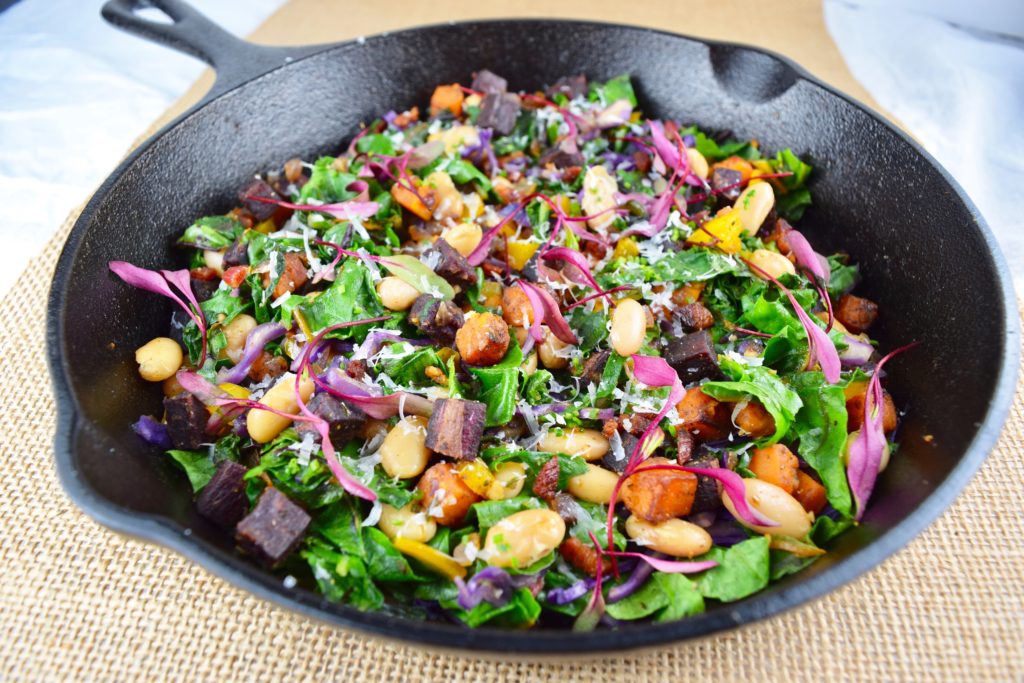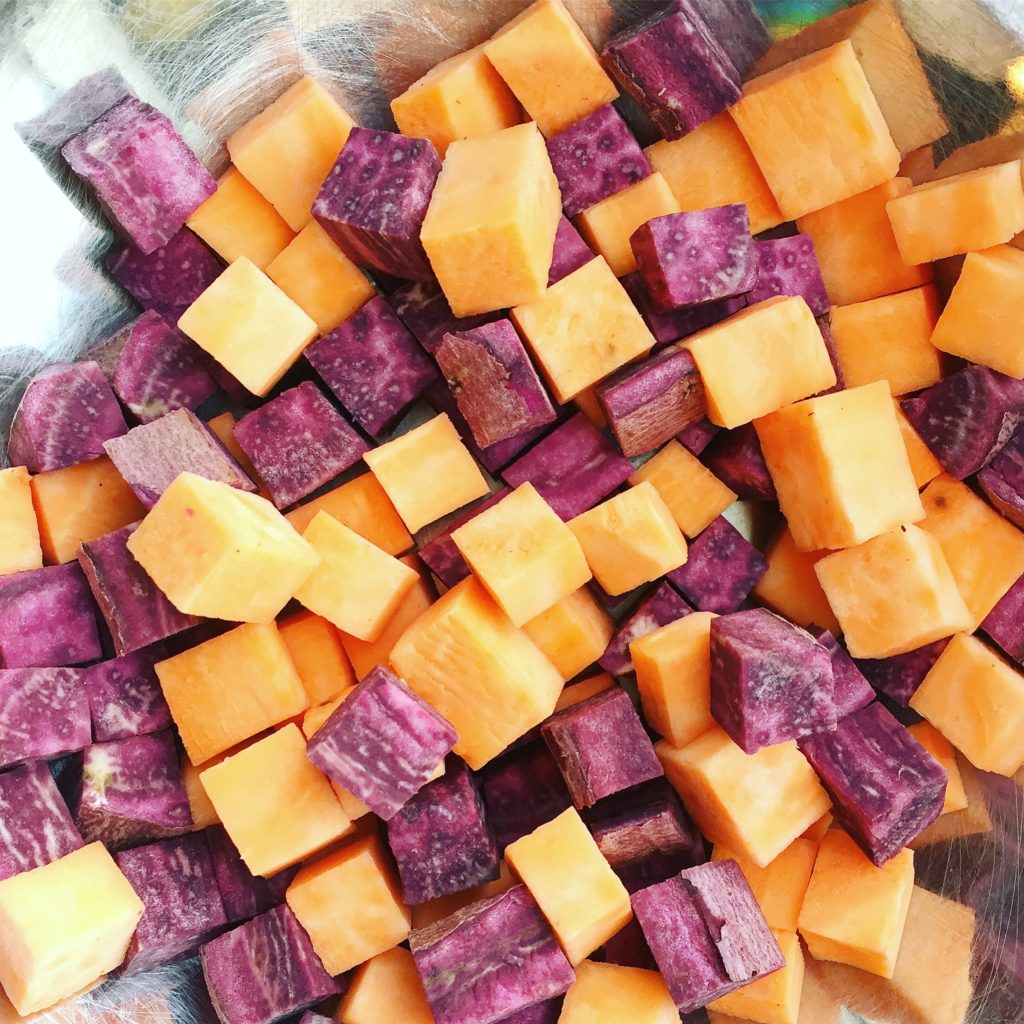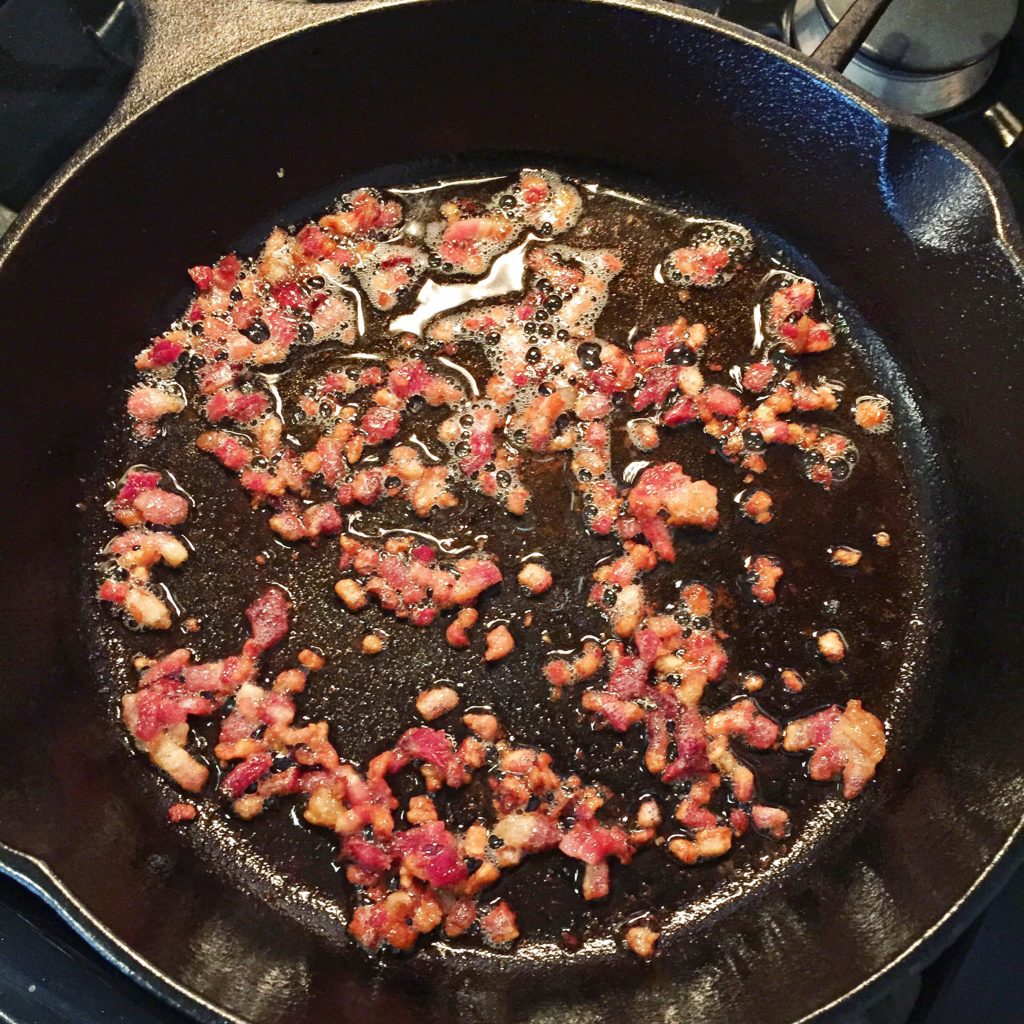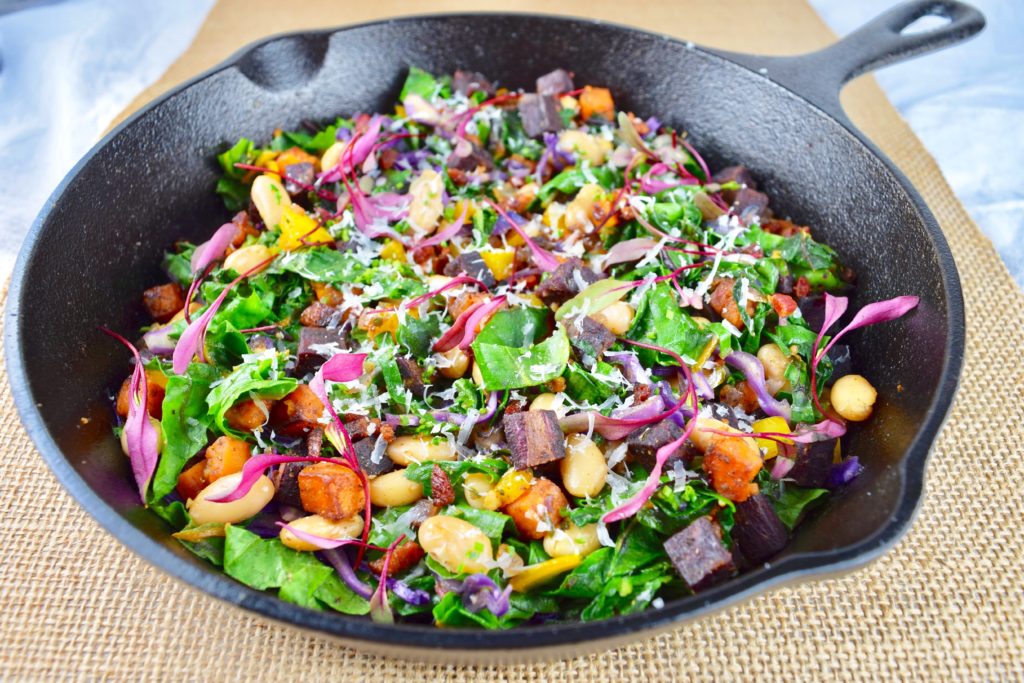Hash is one of those things that every cook should have in their repertoire. It’s easy to make, a great way to use up random bits you have in the fridge, endlessly variable, comes together in 30 minutes or less, only requires one pan, and is suitable to eat any time of day, from early breakfast to late-night munchies. Speaking of breakfast and munchies, this particular hash is fantastic topped with a fried or baked egg if you’re not vegan. And cheese. You can always add cheese. (Or vegan cheese – Treeline Classic Aged Nut Cheese is fabulous grated over this. That’s what I used.)
I’ve always loved the combination of white beans and sweet potato – in chili, in soup, mashed or pureed – the pairing just works. When greens are also involved kale usually gets the nod, but here I’ve chosen to use chard instead. It’s one of my favorite greens with sturdy yet tender leaves, and the red and rainbow varieties have beautiful bright stalks that are completely edible and add a lovely texture to the dish. Don’t like chard? Use kale. I’d suggest sticking with the more delicate and tender lacinato variety (a.k.a. dino kale or black kale) because it’ll wilt at the same rate as chard and it’s not as fibrous and lethery as the other varieties. Cabbage is another green that appears in hash on occasion. I love it and it adds another layer of texture and color so I’ve tossed in some purple cabbage here.
Classic hash is traditionally made with starchy white potatoes, but we’re not using them here. Don’t get me wrong, I think white potatoes are great. In fact, one of my all-time favorite dishes (and childhood memories) is NJ diner-style home fries, made with white potatoes and cooked in a manner similar to hash. Today, however, we’re going with sweet potatoes. Which, by the way, aren’t technically even potatoes. White potatoes are from the Solanaceae or nightshade family, and sweet potatoes belong to the Convolvulaceae or morning glory family. Oh, and yams? NOT sweet potatoes. They’re from the Dioscoreaceae family and have white flesh with rough, hairy skin.
Have I confused you enough? Sorry, I have a tendency to geek out when it comes to food science. I’ll try to keep my digressions under control.
Look at these purple and orange sweet potatoes. Gorgeous, huh? I happened to have a purple one on hand this time, but I typically use orange or white sweet potatoes for this dish. Don’t feel as though you need to go out and track down purple ones. (P. S. White sweet potatoes exist too, so if that’s what you can find, use ’em.)
So, back to the recipe – sweet potatoes, rainbow chard (or kale), and white beans. Which variety of white beans? I suggest cannellini, great northern, or lima. You can use navy beans in a pinch, but they’re a bit small; I prefer larger ones for this recipe. Whether you use beans that you cooked previously from dried or crack open and drain a can is completely up to you. The only difference is that canned beans can be a bit mushy, so they may fall apart when you’re tossing everything together.
There are two other essential components of hash: onions and peppers. Once again, choices abound. Red onion, white onion, yellow onion, sweet onion…you can even use leeks if you want to get fancy. They’re all options. Same goes for the peppers – green bell pepper is classic, but feel free to use red, yellow, orange, cubanelle, or even poblano to add some extra heat. I’ve opted for a sweet bell pepper this time around because I’m out of poblanos and green bells don’t agree with me. There’s also some serrano or jalapeño chile for kick, and you can control the strength of that kick depending on how you trim the chilies. If you’re not a chile-head like me, remove the seeds and most of the white rib to tone down the heat.
One last thing that you’ll often find in hash is cured meat – bacon, pancetta, chorizo and corned beef are common. We’re not using any here, but if you eat meat and want to add some to yours, go for it! Cut 4 ounces of your cured meat of choice into chunks, render until crisp, set aside to drain on paper towels, and use the rendered fat in place of the oil/ghee called for in the recipe. If the meat is already heavily salted the rendered fat will be as well, so go easy when salting the dish later on. Taste it first!
Chopped Niman Ranch Double Smoked Uncured Bacon rendering away. See the liquid pooling in the pan? That’s all fat from the bacon, I didn’t add a drop. If you’re planning to add meat to your hash, don’t cut it so small – I only chopped it this way to render out the fat and reserve the crispy bacon bits for my cats because they lovelovelove them. (Yes I’m a crazy cat lady. Don’t judge.) For you, large 1” dice/chunks would be a good call.
Okay, I think we’ve covered all the major elements. The spices and herbs are intended to complement the ingredients I used, but again, feel free to adjust/substitute/omit according to your taste. One specific item worth mentioning – the sherry vinegar. It’s one of my absolute favorite ingredients, and a fabulous finisher for this hash. If you don’t have it or don’t like it, you can substitute red wine vinegar; it’s not the same, but it’ll do. I wouldn’t forgo the vinegar entirely as it contributes a lovely acidity that rounds out the flavors and ties everything together, but if you’re totally anti-vinegar try a squeeze of fresh lemon or lime instead.
Now get cooking!
- 2 tablespoons olive oil, coconut oil or ghee*
- 1 large organic sweet potato (about 1 lb), scrubbed and diced (peeled if not organic)
- 1 medium onion (about 8 oz), diced
- Kosher salt
- 1 small sweet bell pepper (4-6 ounces), diced
- 1-2 jalapeño or serrano chiles, finely diced (ribs and seeds removed first if you want less heat)
- 1 teaspoon minced garlic
- 1 teaspoon finely chopped fresh rosemary
- 1 teaspoon finely chopped fresh sage
- 1 teaspoon toasted ground cumin seed
- ½ teaspoon toasted ground coriander seed
- ½ teaspoon sweet smoked paprika
- Freshly ground black pepper
- 16 oz cooked (about 2 cups) white beans** - I suggest cannellini, lima or great northern
- 1 small bunch chard (any variety) washed and dried, leaves sliced into ribbons, stems diced
- 1 cup shredded cabbage
- 1 tablespoon minced chives
- 1 tablespoon finely chopped parsley
- Aged sherry vinegar for drizzling
- Optional: ¼ cup freshly grated or shredded Parmigiano or vegan cheese
- In a large cast iron or stainless skillet, heat 1 tablespoon oil or ghee (or rendered pork fat) over medium-high heat until shimmering. Add diced sweet potato and a pinch of salt, and cook for 7-8 minutes, tossing occasionally, until nicely browned in spots and beginning to crisp.
- Add onion, bell pepper, chile, chard stems, and another pinch of salt. Continue to cook, stirring occasionally, until peppers begin to soften and onion is soft and translucent (about 5 minutes).
- Add remaining tablespoon of oil or ghee, garlic, thyme, sage, cumin, coriander, paprika, and 2-3 grinds of black pepper, toss or stir to combine, and cook for 1-2 more minutes.
- Add beans, chard leaves and cabbage, and cook until beans are heated through and chard and cabbage are wilted and tender, about 5 minutes. (You can add a tablespoon of water or stock and cover the pan with a lid to encourage wilting here if you’d like to.)
- Season to taste with salt and pepper, and divide among four plates or bowls. Garnish with chives and cheese, and finish each serving with a drizzle of good aged sherry vinegar. Dig in!
**To end up with 16 oz of cooked beans, start with one cup or 227 grams dried beans. You may also substitute canned beans that have been drained and rinsed.






I made this dish for some friends and it was an absolute hit! The flavors came together so well and as someone who isn’t the biggest fan of sweet potatoes, I gobbled this up. Definitely adding this to my normal rotation of recipes.
Thanks so much for your feedback, Jaclyn! I’m thrilled that you and your friends enjoyed it so much.